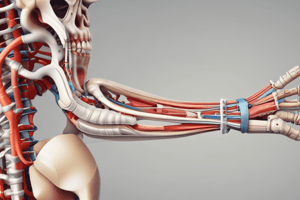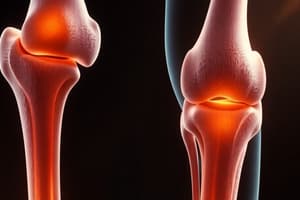Podcast
Questions and Answers
What is the primary function of the bursa in synovial joints?
What is the primary function of the bursa in synovial joints?
- To reduce friction between tendons and bones (correct)
- To produce synovial fluid
- To connect muscles to tendons
- To stabilize the joint during movement
Which type of synovial joint allows for movement in multiple directions?
Which type of synovial joint allows for movement in multiple directions?
- Ball-and-socket joint (correct)
- Hinge joint
- Pivot joint
- Saddle joint
What does Hilton’s law state regarding nerve supply to joints?
What does Hilton’s law state regarding nerve supply to joints?
- Nerves only provide pain sensation in injuries
- Nerves only supply the joint, not the surrounding muscles
- Nerves supplying a joint also supply the muscles that move it (correct)
- Nerves are not involved in joint sensation
What is the main characteristic of uniaxial joints, such as hinge joints?
What is the main characteristic of uniaxial joints, such as hinge joints?
What property of synovial fluid contributes to its function in joints?
What property of synovial fluid contributes to its function in joints?
What is the primary characteristic of synarthroses joints?
What is the primary characteristic of synarthroses joints?
Which classification of joints is characterized by a joint cavity and synovial fluid?
Which classification of joints is characterized by a joint cavity and synovial fluid?
What type of fibrous joint allows the least mobility?
What type of fibrous joint allows the least mobility?
Gomphosis joints are specifically found in which part of the body?
Gomphosis joints are specifically found in which part of the body?
Which joint classification is directly related to bones connected by dense connective tissue?
Which joint classification is directly related to bones connected by dense connective tissue?
What type of joint is formed by two bones joined by fibrocartilage?
What type of joint is formed by two bones joined by fibrocartilage?
Which of the following correctly describes a synchondrosis?
Which of the following correctly describes a synchondrosis?
What is the primary function of cartilaginous joints?
What is the primary function of cartilaginous joints?
Which statement about syndesmosis is true?
Which statement about syndesmosis is true?
What change occurs to synchondroses as a person ages?
What change occurs to synchondroses as a person ages?
What type of cartilage is primarily found at the ends of bones in synovial joints?
What type of cartilage is primarily found at the ends of bones in synovial joints?
Which of the following components surrounds the joint cavity of a synovial joint?
Which of the following components surrounds the joint cavity of a synovial joint?
What is the function of synovial fluid in a synovial joint?
What is the function of synovial fluid in a synovial joint?
What type of reinforcement is often added in some joints, replacing ligaments in areas of high movement?
What type of reinforcement is often added in some joints, replacing ligaments in areas of high movement?
What role do receptors play in the functioning of synovial joints?
What role do receptors play in the functioning of synovial joints?
Flashcards
Arthrology
Arthrology
The study of joints or articulations in the body.
Fibrous Joints
Fibrous Joints
Joints where bones are connected by fibrous tissue, allowing limited movement.
Fibrous Joint: Sutures
Fibrous Joint: Sutures
A type of fibrous joint found only in the skull, with bones connected by fibrous tissue.
Fibrous Joint: Gomphosis
Fibrous Joint: Gomphosis
Signup and view all the flashcards
Classification of Joints: Synarthroses
Classification of Joints: Synarthroses
Signup and view all the flashcards
Syndesmosis
Syndesmosis
Signup and view all the flashcards
Interosseous membrane
Interosseous membrane
Signup and view all the flashcards
Synchondrosis
Synchondrosis
Signup and view all the flashcards
Symphysis
Symphysis
Signup and view all the flashcards
Cartilaginous joint: Which type is stronger?
Cartilaginous joint: Which type is stronger?
Signup and view all the flashcards
Synovial Joint
Synovial Joint
Signup and view all the flashcards
Articular Cartilage
Articular Cartilage
Signup and view all the flashcards
Synovial Fluid
Synovial Fluid
Signup and view all the flashcards
Fibrous Capsule
Fibrous Capsule
Signup and view all the flashcards
Ligaments
Ligaments
Signup and view all the flashcards
Bursa
Bursa
Signup and view all the flashcards
Hilton's Law
Hilton's Law
Signup and view all the flashcards
Proprioceptive Sensation
Proprioceptive Sensation
Signup and view all the flashcards
Uniaxial Joint
Uniaxial Joint
Signup and view all the flashcards
Study Notes
Support and Movement 2: Arthrology
- Arthrology is the study of joints or articulations.
- It's derived from Greek words: arthron (joint) and logos (study).
Content
- Definition of joints
- Classification of joints (based on structure and function)
- Characteristics of synovial joints
- Joint disorders (Osteoarthritis and Rheumatoid Arthritis)
Definition
- Greek: arthron, joint, denoting a joint or articulation
- Greek: logos, study
Classification of Joints (Based on Structure)
- Fibrous Joints:
- Allow very limited movements.
- Bones are connected by fibrous tissue.
- Types:
- Sutures (skull): articulation by process & indentation, coronal suture binds frontal and parietal bones, fibrous connective tissue connects bones.
- Gomphoses (teeth): conical process fits into a socket (e.g., roots of teeth into alveoli of maxillae and mandible).
- Syndesmoses (distal tibiofibular joint): surface united by an interosseous ligament.
- Cartilaginous Joints:
- Allow limited movement.
- Bones are connected by cartilage.
- Types:
- Synchondroses (temporary): epiphyseal plate (youth), cartilage ossifies in adult life (e.g., epiphysis of child).
- Symphyses (secondary): two bones joined by fibrocartilage (e.g., inter-body joints of the spine, pubic symphysis).
- Synovial Joints:
- Most common type.
- Bone ends covered by articular cartilage.
- Joint cavity containing synovial fluid.
- Articular capsule encloses joint cavity.
- Synovial membranes secrete synovial fluid.
- Types of synovial joints (based on movement): hinge, pivot, condylar, saddle, plane, ball-and-socket.
Classification of Joints (Based on Function)
- Synovial Joints:
- Hinge (uniaxial): flexion and extension only (e.g., elbow, knee)
- Pivot (uniaxial): rotary movement in one axis (e.g., C1/2, proximal radioulnar)
- Condylar (ellipsoid, biaxial): angular movement in two directions (e.g., wrist, metacarpophalangeal joint)
- Saddle (biaxial): saddle-shaped heads permit movement in two planes (e.g., carpometacarpal joint of thumb)
- Plane (biaxial): gliding or sliding movements (e.g., intercarpal, facet of spine, superior tibiofibular, acromioclavicular)
- Ball-and-socket (multiaxial): movement in all directions (e.g., hip, glenohumeral)
Joint Disorders
- Osteoarthritis (OA):
- Degenerative and progressive loss of joint cartilage.
- Factors: aging, obesity, joint irritation, muscle weakness, wear/abrasion.
- Common reason for hip and knee replacement surgery.
- Rheumatoid Arthritis (RA):
- Autoimmune disease where cartilage and joint linings are attacked by the immune system.
- Inflammation of the synovial membrane.
- Formation of abnormal granulation tissue.
Stability of Joints
- Articular surfaces (shape, size, arrangement)
- Ligaments and capsule
- Muscle tone around the joint
Movement of Synovial Joints
- Gliding: flat surfaces move back-and-forth and side-to-side.
- Angular Motions: flexion, extension, lateral flexion, abduction, adduction, circumduction, and rotation.
Clinical Check Point
- Physiotherapy for OA
- Occupational therapy for RA.
Studying That Suits You
Use AI to generate personalized quizzes and flashcards to suit your learning preferences.
Related Documents
Description
This quiz covers the essential aspects of arthrology, focusing on the study of joints and their classifications. It delves into the characteristics of synovial joints and common joint disorders such as osteoarthritis and rheumatoid arthritis. Test your knowledge on the anatomy and function of joint structures.




